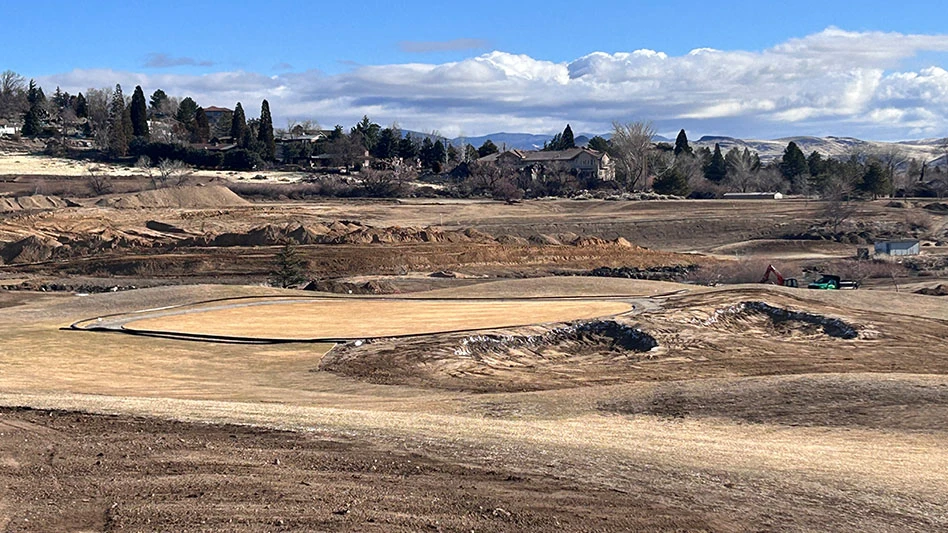They are the individuals in the forefront and the people behind the scenes. They have to know when to speak their minds and when just to listen. They are sources of information about such complexities as how the land that’s being worked on reacts to certain weather and such simplicities as where to get a good price on sand or sod from a vendor.
When it comes to working with an architect and builder on a renovation or new construction project, golf course superintendents take on roles as vast as the land they work on. Tom Shapland, regional president of Wadsworth Construction who’s based in Plainfield, Ill., and president of the Golf Course Builders Association of America, says working with architects and builders is a juggling act for golf course or grow-in superintendents.
According to knowledgeable golf course industry personnel, the superintendent’s role comprises some of the following, in no particular order:
• Being involved with hiring the architect and then working as an advisor for that designer;
• Helping administer the contract and keeping an eye on expenses and the bottom line of the project;
• Relaying questions and answers between the owner and builder;
• Helping assemble and coordinate a design team that could include integral members of the project such as the architect, land planner, engineer and irrigation consultant;
• Working closely with the construction superintendent;
• Working with contractors to solicit and receive bids;
• Helping set the maintenance-program budget once the project is completed;
• Selecting project materials that are available now and in the future; and
• Overseeing the installation of the irrigation and drainage system.
It’s no wonder Greg Muirhead, president of the American Society of Golf Course Architects, calls golf course superintendents “Clerks of the Works.”
Integral to success
One of the most important aspects of the superintendent’s juggling act that Shapland refers to is serving as a liaison/point person between the golf course owner and the builder and architect. In that role, a superintendent assists as a question-and-answer conduit who helps make decisions during construction.
“His strongest role is to be the owner’s representative, looking out for the long-term effect of the project on the golf course,” Shapland says. “He’s the go-between between the owner – or committee in the case of a private club – the architect and sometimes the engineer. A superintendent still has ongoing responsibilities to the club; but at the same time, he should be involved not only with what’s being installed, but how it’s being installed and where it’s being installed so he can serve the ownership better in the long run.”
Whether working on a renovation or a new construction project, a golf course superintendent’s responsibilities are similar, Muirhead says.
“Primarily with renovations, oftentimes it’s the golf course superintendent who’s the key person explaining to the club why things are necessary,” says Muirhead, a golf course architect with Rees Jones Golf Course Design. “He or she is the person that probably has the most intricate and detailed knowledge of the land itself and how that land reacts, so they’re often the person explaining to the club why things are the way they are and maybe when it’s time to bring a golf course architect in for a review.
“As architects, we’re there once every week or once every 10 days, but superintendents are there 24/7,” Muirhead adds. “We’re in close communication with them almost daily, making sure things are getting done the way we want them to get done. From the club’s perspective, a superintendent is usually the key person in terms of initial input and seeing the job through the design phase and construction.”
A golf course superintendent works best as an advisor to the architect, says Charles Clark, golf course superintendent at Red Rocks Country Club in Denver.
“Architects feel very strongly, and they have their own styles, but as they develop that style, superintendents can feed them information, which should help,” Clark says. “Superintendents can give architects good ideas about the things they’re designing and whether it’s possible to maintain them. Superintendents need to give architects a good understanding of everything, from the type of grasses that live and survive in that area the best to soils and irrigation systems.”
Working closely with a builder also is integral to the success of a renovation or new construction project. Joe Salvatore, vice president of construction for Austin, Texas-based Golf Works, says there’s daily contact and conversations between his construction supervisor and the golf course supervisor about how the project is progressing.
“He might want to get one piece done sooner or work on a certain program he has that we might adjust to make his job easier, and then he does the same back for us,” Salvatore says. “It depends on the superintendent. Sometimes he’s just a grass man, and other times he has a lot of construction experience.”
Yet, no matter how much experience golf course superintendents have, it’s important they agree with the builder and architect working on the project.
“It’s pretty critical that everybody’s on the same page,” Muirhead says. “We’ll come in and evaluate and offer our vision.
“In most cases, it’s generally accepted that we’re the experts and what we think needs to be done is typically accepted,” he adds. “In certain instances, the club and the superintendent are the people that live with the facility day in and day out and have been for several years, so they often have great input about what they’re experiencing and what they think might make it a more enjoyable experience. We don’t hesitate to seek that kind of input and implement it if we feel it’s justifiable.”
No neglect
Overall, Salvatore says superintendents should be prepared for long hours and hard work when working with an architect and builder on a construction project. But, as Shapland cautions, in the case of renovations, they shouldn’t forget about the parts of the golf course that don’t need to be fixed.
“With a partial renovation, sometimes a superintendent can get overly involved with the construction aspect and lose sight of his primary job of keeping the rest of the golf course playable and in good shape,” Shapland says.
“Unfortunately, I’ve seen more superintendents get in trouble with ownership because they got too involved with the construction part of the work and lost sight of the other nine or 12 holes they were trying to maintain.” GCN
Bob Seligman is a freelancer writer based in Suffren, N.Y. He can be reached at bhseligman@aol.com.
Suggestions for superintendents
By Bob Seligman
Sometimes working with builders and architects on renovation or new construction projects can be tricky for golf course superintendents. Successfully working with both has much to do with presentation and personality. There’s also no cookie-cutter formula, but communication and preparation are key areas to concentrate on. That said, here are some key do’s and don’ts for superintendents to think about:
“Let the architect express his opinions. Listen to the design work he wants to do without being too confrontational about any single item. Let him present his plan without any interference until it’s complete. That’s when a superintendent needs to voice any concerns he’s identified so a discussion can take place. He always needs to maintain his cool. In the end, the architect is usually going to get his way. You’re going to be able to give him some input where he might change some things here and there, but communication is the secret.” – Charles Clark, golf course superintendent, Red Rocks Country Club, Denver
“Remember that the purpose of a renovation or new project isn’t to make the superintendent’s job easier; it’s to make the golf course better. A superintendent needs to keep that mindset while he listens to the architect and figures out how to maintain what the architect has implemented and designed and what the contractor has implemented, rather than why he can’t maintain those things.” – Tom Shapland, regional president of Wadsworth Golf Construction and president of the Golf Course Builders Association of America.
“Completely understand the scope of the contract for renovations and new work.” – Tom Shapland
“Do your homework regarding selection of team members, construction materials, etc. Communicate effectively with all team members, club personnel and members. Ensure the final product is maintainable within your budget.” – Greg Muirhead, president of the American Society of Golf Course Architects and golf course architect with Rees Jones Golf Course Design
“Don’t get too worried about the construction process. If you have a qualified contractor, they know how to
do their job.” – Joe Salvatore, vice president of construction, Golf Works
“If a superintendent sees something that he doesn’t like or doesn’t understand, don’t wait until construction is complete to bring it up. Bring it up as soon as you can. Discuss it and move on.” – Tom Shapland
“Don’t ever insist that something be done your way or no way.” – Charles Clark
“No matter what the positives or negatives are, the project is going to happen, so don’t get too excited and keep a level head.” - Joe Salvatore.
“Don’t forget there’s a lot of pressure on every side, but superintendents need to remember we’re all in it together and partnered up. Everybody’s after the same goal – the architect, the builder and the superintendent.” – Joe Salvatore

Explore the September 2006 Issue
Check out more from this issue and find your next story to read.
Latest from Golf Course Industry
- The Cabot Collection announces move into course management
- Carolinas GCSA raises nearly $300,000 for research
- Advanced Turf Solutions’ Scott Lund expands role
- South Carolina’s Tidewater Golf Club completes renovation project
- SePRO to host webinar on plant growth regulators
- Turfco introduces riding applicator
- From the publisher’s pen: The golf guilt trip
- Bob Farren lands Carolinas GCSA highest honor







